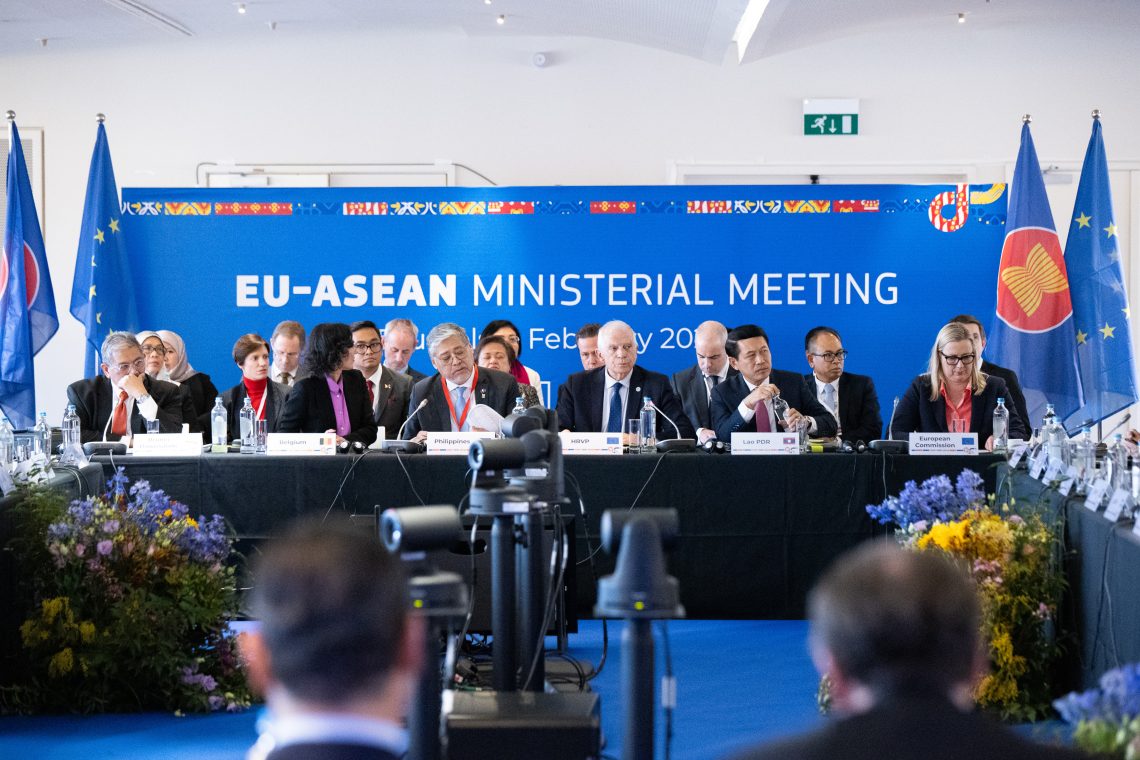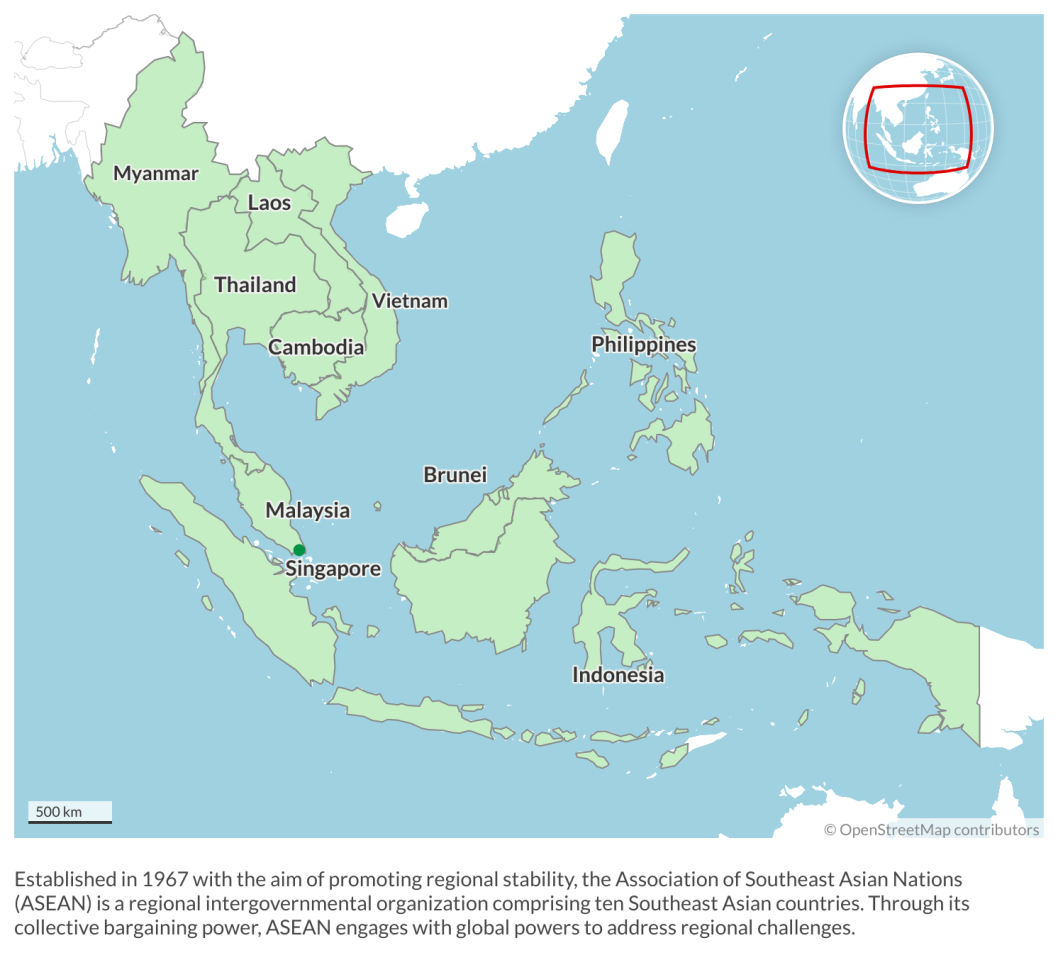The future of Europe’s Southeast Asia engagement
Relations between Southeast Asia and Europe have evolved on many fronts, and will likely keep developing despite geopolitical tensions.

In a nutshell
- Shared challenges mean Europe’s and Southeast Asia’s strategic interests are aligning
- The European Union is trying to grow its security footprint in the region
- This rapprochement remains vulnerable to major geopolitical events
Ties between Europe and Southeast Asia have seen an uptick in recent years due to several converging interests. The European Union and key European states recognize the opportunities Southeast Asia presents as part of the wider Indo-Pacific growth story. They are also partially aligned in facing challenges to the rules-based international order.
For Southeast Asian countries and the Association of Southeast Asian Nations (ASEAN) as a bloc, Europe is one of many partners to engage as part of a multi-aligned approach that extends beyond the narrow bipolar lens of United States-China competition. This common ground has manifested itself through bilateral agreements, as well EU-ASEAN cooperation. In 2020, the two agreed to become strategic partners. Collaboration then intensified with a blueprint to further operationalize cooperation in December 2022.
The EU has pledged 10 billion euros for connectivity projects in Southeast Asia. It has also made inroads with key countries in the region, including a new digital agreement with Singapore as well as an energy transition partnership with Vietnam.
Individual European countries have been pursuing closer ties to Southeast Asia as well. Some, such as France, Germany and the Netherlands, have done so as part of broader, formal Indo-Pacific strategies. Others, like the United Kingdom, have been in the spotlight for deployments to the South China Sea and cross-continental initiatives like the AUKUS security pact to counter China’s rise in the Indo-Pacific region.
Facts & figures
Yet Europe’s engagement in the region has not been without challenges. There are periodic economic issues that remain unsolved, like palm oil disputes or wider regional anxieties over the EU’s carbon policies. Regional and global geopolitical challenges like Myanmar or the Israel-Gaza war also complicate the EU’s engagement with some Southeast Asian countries given diverging views in the region.
At the February 2024 EU-ASEAN ministerial meeting, EU High Representative Josep Borrell admitted that engagement had to take into account “different approaches to several questions,” which attested to divergences on issues such as Russia’s invasion of Ukraine and the Israel-Hamas conflict. In a wider sense, the European Union’s progress in establishing a stronger presence in security matters has been slower than it would like. For instance, the EU is not yet a full participant in the ASEAN Defense Ministers’ Meeting Plus, widely considered the association’s most important defense framework.
More by Prashanth Parameswaran
- Thailand’s foreign policy vision collides with reality
- Indonesia’s foreign policy after the 2024 presidential elections
Looking ahead, the key question is how ties will evolve in the coming years. This will play out amid other domestic, regional and global realities for both Southeast Asia and Europe. For Southeast Asia, the twin geopolitical challenges of the South China Sea and Myanmar, as well as work on ASEAN’s post-2025 push to boost the institution’s unity and relevance will likely continue to consume the region. The trend of regime transitions in Southeast Asia will also continue, for example with a leadership succession in Singapore and a new government in Indonesia. These dynamics will naturally affect some of Southeast Asia’s engagements with its key partners.
Meanwhile, Europe will soon see several decisive elections, and the Russia-Ukraine conflict will raise questions about its ability to sustain its commitment to Southeast Asia and the wider Indo-Pacific region. The ability of European states to translate commitments into concrete actions and projects will likely be pivotal in how the situation develops.
Scenarios
Most likely: Continuity in strengthened EU-ASEAN engagement
Here, the EU and European states continue to make incremental inroads with ASEAN as well as with individual Southeast Asian countries. This includes progress on some individual bilateral economic trade deals with countries like Thailand, which could act as stepping stones toward an ambitious and previously elusive EU-ASEAN free trade pact.
There could also be further strategic agreements similar to those seen recently, like strategic port development in Malaysia or a digital economy package for the Philippines. Defense inroads could also occur, both through bilateral cooperation or with ASEAN regional centers, on cybersecurity, humanitarian assistance or disaster relief.
The EU’s successes could also expand with like-minded partners in the region, perhaps through innovative mechanisms like the Just Energy Transition Partnerships or through more collaboration on infrastructure projects via the EU’s Global Gateway. These initiatives would continue despite occasional tensions and respective challenges.
Moderately likely: Broadening of the EU’s regional role
In this scenario, the EU and European states would not just continue to make progress in certain economic areas, but would also redefine Europe’s role in Southeast Asia, becoming a crucial strategic and security partner.
The EU could have an impact in sectors strategic for Southeast Asia, including artificial intelligence. This would further intensify perceptions of the EU as a regulatory authority in the contest for regional and global rules and norms.
European powers could become a more regular feature in minilateral and multilateral military exercises and other actions that seek to address China’s assertiveness in the South China Sea. As this occurs, the EU may even begin to be seen by some Southeast Asian states as a better hedge against Washington and Beijing in the context of U.S.-China competition, rather than just one of several partners.
Less likely: Retrenchment
The third and least likely scenario is the retrenchment scenario. While few expect this to occur given the mutual interests on both sides, it cannot be ruled out. Under this scenario, Europe may find it difficult to deliver on its commitments to Southeast Asia and turn increasingly inward, due to factors such as an intensification of its Russia conundrum, leadership changes and economic difficulties.
Southeast Asia may also face obstructions to closer ties with Europe. ASEAN could see its relevance diminish further amid internal and external challenges, and some Southeast Asian states could move even closer into China’s orbit in some aspects. This would make it difficult for European states to engage and shape rules and norms in certain sectors.
Some key governments could also adopt more anti-Western stances, resisting higher standards in some areas of engagement with the EU and some European states. This could also become evident if regional issues – for example Myanmar – worsen. There could be a growing divide between more forward-leaning European countries and ASEAN’s lowest-common-denominator approach as a bloc.
For industry-specific scenarios and bespoke geopolitical intelligence, contact us and we will provide you with more information about our advisory services.










